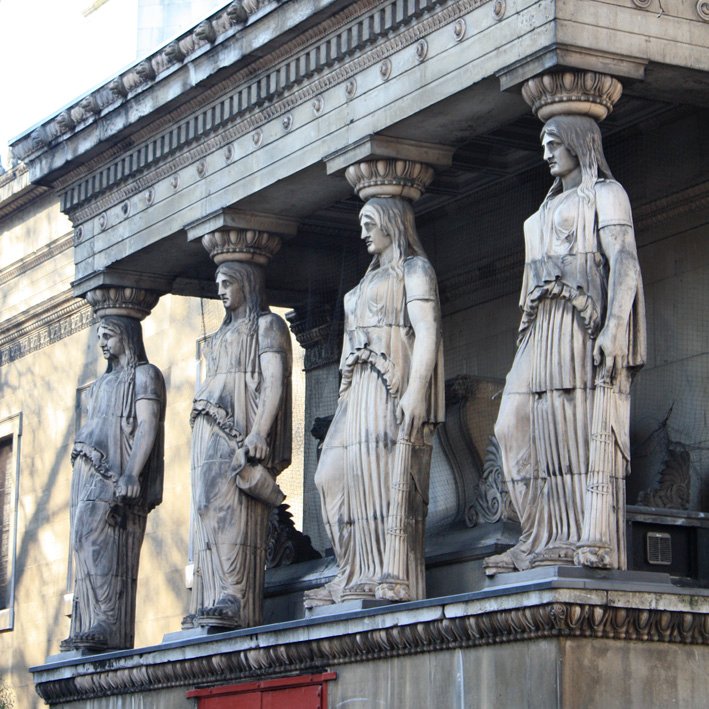Russell Square Station - Herbrand Street - Tavistock Place - Tavistock Square - Gordon Square - Taviton Street - Endsleigh Gardens - Woburn Walk - Burton Street - Cartwright Gardens - Marchmont Street - Russell Square Station (about 1 hour)
Emerging from Russell Square Underground Station, turn left and cross the road into Herbrand Street, heading northwards. On the left you immediately see the lively Art Deco detailing of the former Daimler Garage, stuccoed concrete of 1931 by Wallis, Gilbert & Partners. Further up, beyond Coram Street, good examples of public housing in the stock brick Peabody Estate on the right and the even better vernacular revival-influenced gables of the LCC housing on the left.

Now you come to Tavistock Place, developed around 1800, where turning left you will confront on the north side a very different building, one of the outstanding Victorian designs of Bloomsbury, Mary Ward House, progressive Arts & Crafts of 1895-7 by Smith & Brewer. Carry on to the junction with Tavistock Square, and turn right. Walking north up the east side, you soon come to the grand red brick Edwardian Baroque headquarters of the British Medical Association, designed around 1911 by Sir Edwin Lutyens but finished with the monumental range facing the square by C. Wontner-Smith in 1925-9. It is built on the site of James Burton's Georgian villa.

Cross the road into Tavistock Square, and walk westwards, past the attractive Art Deco blocks of Woburn House and Tavistock Court, then head south again on the west side of the square. Here you pass the smart, elegantly classical terraces of the most prolific of the early nineteenth century developers of London, Thomas Cubitt, with their Ionic giant pilasters. At the bottom you reach Torrington Place, where you should now turn right, going on until you get to Gordon Square. Go into the delightfully planted gardens of this square, where you will see some interesting buildings on both sides - to the right, the Cubitt terrace which includes houses where various members of the Bloomsbury Set and their circle of friends lived, and to the left, the fine former Catholic Apostolic, now University Church, Early English Revival by Raphael Brandon, the adjacent High Gothic former clergy house, and the more playful Tudor Gothic University Hall, opened in 1848 as a residential hall for Unitarians at University College.


At the north end, turn right and continue north into Taviton Street, more early nineteenth century terraces by Cubitt, and here a good recent building is worthy of mention, the inventive and interestingly detailed School of Slavonic Studies by Short & Associates (2004). At the end you face Endsleigh Gardens, which when originally developed by Cubitt formed the south side of Euston Square. Here you confront the back elevation of the elegant Neo-Georgian Friends' House of 1925-7 by H. Lidbetter. Then turn right and continue eastwards past more typical Cubitt, and the attractive and surprisingly late (1954-8) Bentham House, back into Woburn Place, where the strict Greek Revival St. Pancras Church of 1822 by H&W Inwood looms on the other side. Turn right and cross the road to go into Woburn Walk, more Cubitt, but on a much more intimate scale, in the shape of well-preserved commercial shopfronts of about 1822, creating a fine sense of Bloomsbury's history with their Greek Revival decoration. Go on a little way south down Burton Street, noting its typical James Burton terraces, then turn left into Burton Place, after looking at the fine Neo-Georgian back elevation of Lutyens' British Medical Association building. Here there are more Burton Regency houses. Then go on into Cartwright Gardens, once an upmarket townhouse crescent, again by Burton.

From here, turn right and head back south again into Marchmont Street. As you get past Tavistock Place, you can contrast the intimate human scale of the Georgian building line on your right with the brutal intrusion of the Brunswick Centre (1968-72) on your left, albeit much improved by its recent facelift. You can revive yourself with a well-earned coffee here before beating a retreat past the Georgian terraces of Bernard Street at the far end, to Russell Square Station, where your tour ends. Fittingly, Bernard Street, built between 1799 and about 1810, was once again the work of James Burton.
Anthony Jennings 2012